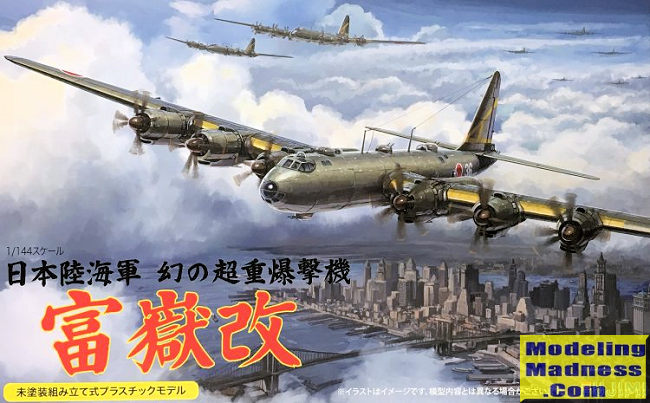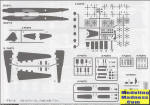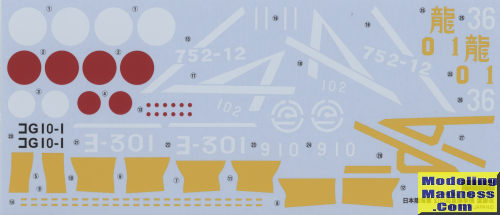
Fujimi 1/144 G10N Fugaku
| KIT #: | 144276 |
| PRICE: | 2520 yen (2800 yen SRP) |
| DECALS: | Seven options |
| REVIEWER: | Scott Van Aken |
| NOTES: | March 2017 release |

| HISTORY |
The Nakajima G10N Fugaku (Japanese: 富岳 or 富嶽, "Mount Fuji"), was a planned Japanese ultra-long-range heavy bomber designed during World War II. It was conceived as a method for mounting aerial attacks from Japan against industrial targets along the West Coast (e.g., San Francisco), Midwestern (e.g., Detroit, Chicago, and Wichita) and Northeastern (e.g., New York and Norfolk) of the United States.
The Fugaku had its origins in "Project Z", a 1942 Imperial Japanese Army specification for an intercontinental bomber which could take off from the Kuril Islands, bomb the continental United States, then continue onward to land in German-occupied France. Once there, it would be refitted and make another return sortie.
Project Z called for three variations on the airframe: heavy bomber, transport (capable of carrying 300 troops), and a gunship armed with forty downward-firing machine guns in the fuselage for intense ground attacks at the rate of 640 rounds per second (i.e. 38400 rounds per minute).
The project was conceived by Nakajima head Chikuhei Nakajima. The design had straight wings and contra-rotating four-blade propellers. To save weight, some of the landing gear was to be jettisoned after takeoff (being unnecessary on landing with empty of bomb load), as had been planned on some of the more developed German Amerika Bomber competing designs. It used six engines, as with the later Amerika Bomber design competitors, to compensate for German aircraft engines being limited to 1,500 kW (2,000 hp) maximum output levels apiece.
Development started in January 1943, with a design and manufacturing facility built in Mitaka, Tokyo. Nakajima's 4-row 36-cylinder 5,000 hp Ha-54 (Ha-505) engine was abandoned as too complex.
Project Z was cancelled in July 1944, and the Fugaku was never built.
| THE KIT |
 One
does not often see kits of Japanese WWII 'whiffers'. There have been some by RS
models, but nothing matches the sheer size of this one. Nicely molded with large
attachment points on the major assemblies and obviously designed to be less than
fiddly, the kit is not high on the 'fiddly' factor.
One
does not often see kits of Japanese WWII 'whiffers'. There have been some by RS
models, but nothing matches the sheer size of this one. Nicely molded with large
attachment points on the major assemblies and obviously designed to be less than
fiddly, the kit is not high on the 'fiddly' factor.
Interestingly, the instructions would have you start with the wings, those and the nacelle parts before moving on to the fuselage. An option here is for the lower cowl flap to be modeled open or closed.
There are holes to open for the gun turrets, of which there are five. The turrets themselves are a whole unit with a separate hold-down so they can swivel. Blanking plates are also provided so it seems that a transport version of this will be kitted sometime in the future. Cockpit is also a single piece, but nicely molded. Attachment areas for the side blisters and the transparencies are large and positive. Each of the two bomb bays have bombs molded in place. The single piece fin and horizontal tailplanes have large slots into which the equally large tabs fit. Same for the wings.
Those with sharp eyes will notice that six bladed props are included along with the four blade variety this version uses. Those were to be used on the original project Z plane with the 36 cylinder engines. The G10N was to be powered by 18 cylinder engines and use the four bladed versions. The Z plane was also over twice as heavy. Once the props are attached to the cowlings so they can spin, the are to be glued onto the wings.
Landing gear are beefy with separate wheels. Gear doors have large pins to provide positive placement. You can also build this one with the bomb bays closed as well as the gear up. This takes a bit of sleuthing to discover, but there is a chart that equates the open pieces with the appropriate closed piece. A display stand is included that is more of a cradle than anything else. It seems one can put a 'gear down, bay open' model on it.
 Instructions
are pretty well all in Japanese as is the norm for Fujimi kits that are not
designed to be exported. Markings are for seven planes. One is a prototype in
overall orange, two are overall unpainted metal and the other four are in dark
green over grey/unpainted metal. All the units are ones that have flown bombers
with either the Navy or Army. The yellow wing leading edge markings are provided
as decals.
Instructions
are pretty well all in Japanese as is the norm for Fujimi kits that are not
designed to be exported. Markings are for seven planes. One is a prototype in
overall orange, two are overall unpainted metal and the other four are in dark
green over grey/unpainted metal. All the units are ones that have flown bombers
with either the Navy or Army. The yellow wing leading edge markings are provided
as decals.
| CONCLUSIONS |
I realize that all of you reading this are going to want to be the first on your block to have one of these kits. They should be pretty easy to build and thanks to the multiple options, you can do several! Probably the most difficult part of the assembly will be applying the prop stripes and the little red fuel tank dots.
| REFERENCES |
https://en.wikipedia.org/wiki/Nakajima_G10N
May 2017
Copyright ModelingMadness.com. All rights reserved. Thanks to
for the review kit. You can find this kit at your favorite hobby shop
or on-line retailer. If you would like your product reviewed fairly and fairly quickly, please
contact
the editor or see other details in the
Note to
Contributors. Back to the Main Page
Back to the Review
Index Page
Back to the Previews Index Page